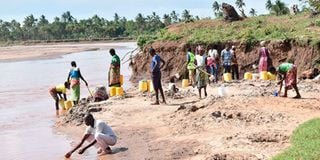Premium
The snail fever sweeping across Coast villages

What you need to know:
- Bilharzia, also known as schistosomiasis, is a waterborne acute and chronic disease caused by a parasitic worm.
- It is transmissible when people suffering from the disease contaminate freshwater sources with their excreta.
In the past one year, Mr Katana Charo, 24, and his five siblings have been battling bilharzia, which has manifested itself through itching and pain on the back.
“My condition worsened when I started spotting blood while peeing,” the father of one told Healthy Nation during a visit at his home in Darajani village, Kilifi County.
The fisherman said the majority of his peers who depend on fishing for their livelihoods are grappling with the disease. “This is because after healing we go back to River Ndzovuni to fish, where we get infected again. It’s a cycle. We never completely heal. We live with it.”
He is among hundreds of coastal residents ravaged by the neglected tropical disease. Bilharzia, also known as schistosomiasis, is a waterborne acute and chronic disease caused by a parasitic worm.
It is transmissible when people suffering from the disease contaminate freshwater sources with their excreta. Although Kilifi County government has been conducting mass drug administration, it has failed to eradicate the disease.
Bilharzia affects the intestine and urinary tract system but it can also affect other body parts through the blood vessels.
Mr Charo said he only seeks medication whenever his condition worsens.
“We depend on this water for survival but any contact with the waters means sickness. The disease affects more adults than children because we don’t allow them to swim due to the snails that cause it,” said the fisherman.
Urging the government to supply residents with sufficient drugs, he revealed that most fishermen would rather use traditional medicines than seek medical attention in hospitals due to stigmatisation.
On the outskirts of Tana River County, men who are battling the disease stay away from medical centres in fear of breaking their marriages. “We don’t seek treatment in hospitals because bilharzia manifests symptoms similar to some sexually transmitted diseases, and stigmatisation is rife. I would rather treat it traditionally,” said Mr James Jillo, a resident.
He said when he was first hit by the bug, he did not disclose the ailment to his wife. But when blood started oozing while peeing, he had to reveal the truth.
“My wife urged me to go for the test, she thought I had syphilis. She accused me of having extramarital affairs. My home turned into a battleground due to my condition. But I resorted to using neem.”
In Sabaki, Mr Kanga Thuva, in his 70’s, was also attacked by bilharzia and has been on medication for months now. “If this water can be piped and treated before we use it, we would reduce the cases of bilharzia,” he said.
During a recent sensitisation programme in Lamu, the Kenya Medical Research Institute (Kemri) senior medical researcher, Dr Jimmy Kihara, said two snails are the main vectors of Schistosomiasis in Kenya.
“You get infected with bilharzia when you get into stagnant water in a river or slow-moving stream, where the parasite will get into your body, blood and gets transported to the liver where they will mature into adult male and female. When they mature, they will produce eggs, which pass through your bladder into urine,” said Dr Kihara.
This report is produced in partnership with the African Investigative Journalism Conference, an initiative of the Journalism Department at the University of Witwatersrand in South Africa, and the Nation Media Group.





